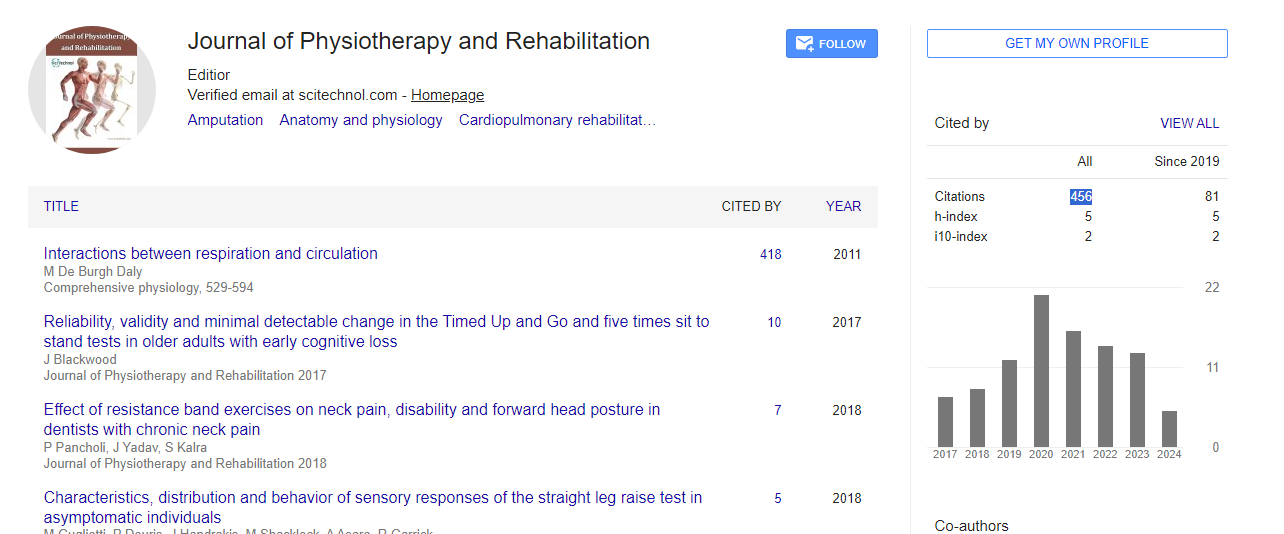Commentary, J Physiother Rehabi Vol: 8 Issue: 4
Challenges and Solutions in Neurorehabilitation: Addressing Barriers to Effective Treatment and Exploring Innovative Approaches
Dan Fefier*
1 Department of Rehabilitation Medicine, University Hospitals of Derby and Burton NHS Foundation Trust, Derby, United Kingdom
*Corresponding Author: Dan Fefier,
Department of Rehabilitation Medicine,
University Hospitals of Derby and Burton NHS Foundation Trust, Derby, United
Kingdom
E-mail: fefierd@n.edu.uk
Received date: 23 July, 2024, Manuscript No. JPTR-24-147316
Editor assigned date: 25 July, 2024, PreQC No. JPTR-24-147316 (PQ);
Reviewed date: 08 August, 2024, QC No. JPTR-24-147316
Revised date: 15 August, 2024, Manuscript No. JPTR-24-147316 (R);
Published date: 22 August 2024, DOI: 10.4172/JPTR.1000172.
Citation: Fefier D (2024) Challenges and Solutions in Neurorehabilitation: Addressing Barriers to Effective Treatment and Innovative Approaches. J Physiother Rehabi 8:4.
Description
Neurorehabilitation is a critical field dedicated to helping individuals recover from neurological impairments resulting from conditions such as stroke, traumatic brain injury and spinal cord injury. Despite significant advancements, practitioners face numerous challenges in delivering effective treatment. Addressing these barriers and exploring innovative approaches are essential for improving patient outcomes and advancing the field. One of the primary challenges in neurorehabilitation is limited access to services, particularly in underserved and rural areas. Many patients struggle to receive timely and appropriate care due to a shortage of specialized rehabilitation centers and professionals. This limitation can delay recovery and irritate long-term impairments.
Telehealth has emerged as a promising solution to bridge the gap in access to neurorehabilitation services. By manipulating digital platforms, patients can receive consultations, therapy sessions and follow-up care from the comfort of their homes. Remote monitoring technologies, such as wearable sensors and mobile apps, enable therapists to track patients progress and adjust treatment plans in realtime, ensuring continuity of care despite geographical barriers. Neurorehabilitation is naturally complex due to the variability in how individuals respond to treatment. Factors such as the type and severity of the neurological condition, patient age, comorbidities and preexisting health conditions can influence treatment outcomes. This variability can make it challenging to design one size fits all rehabilitation protocols.
To address individual variability personalized rehabilitation plans are essential. Advances in genomics, neuroimaging and biomarkers enable clinicians to convert interventions based on a patient’s specific neurological profile. By using data driven approaches to design individualized treatment plans therapists can optimize therapeutic efficacy and improve patient outcomes. Personalized medicine approaches including precision rehabilitation are increasingly used to customize therapies according to each patient’s unique needs. Effective neurorehabilitation often requires a multidisciplinary approach involving physical therapists, occupational therapists, speech therapists, neurologists and psychologists. Coordinating care among multiple specialists can be challenging due to differences in treatment philosophies, communication barriers and fragmented care systems. Implementing coordinated care models can enhance the integration of multidisciplinary care. These models enlarge communication and collaboration among healthcare providers ensuring a linked approach to patient management. Integrated care pathways and multidisciplinary team meetings facilitate information sharing and decision-making leading to more united and comprehensive care.
Additionally case managers or care coordinators can streamline care processes and ensure that all aspects of a patient’s rehabilitation are addressed. Increasing investment in research and clinical trials is important for advancing neurorehabilitation practices. Evidence-based practice involves integrating the best available research with clinical expertise and patient preferences. By prioritizing research on new therapeutic modalities, technologies and rehabilitation techniques the field can continually evolve and improve. Collaboration between academic institutions research organizations and clinical practitioners can accelerate the development and implementation of evidence based treatments. Effective patient and family education is key to overcoming this barrier. Providing clear accessible information about the rehabilitation process treatment goals and home exercises helps patients and their families understand and adhere to treatment plans. Support groups, educational workshops and interactive tools can empower patients and caregivers caring for a collaborative approach to rehabilitation and promoting better attachment to therapy.
Conclusion
Neurorehabilitation faces several challenges including limited access to services individual variability in treatment response, the need for multidisciplinary care, limited evidence based practices and patient engagement issues. Addressing these barriers through innovative solutions such as telehealth, personalized treatment plans, coordinated care models, increased research and enhanced patient education can significantly improve therapeutic outcomes and advance the field. By continuing to explore and implement these strategies, neurorehabilitation can provide more effective and equitable care ultimately enhancing the quality of life for individuals with neurological impairments.
 Spanish
Spanish  Chinese
Chinese  Russian
Russian  German
German  French
French  Japanese
Japanese  Portuguese
Portuguese  Hindi
Hindi 